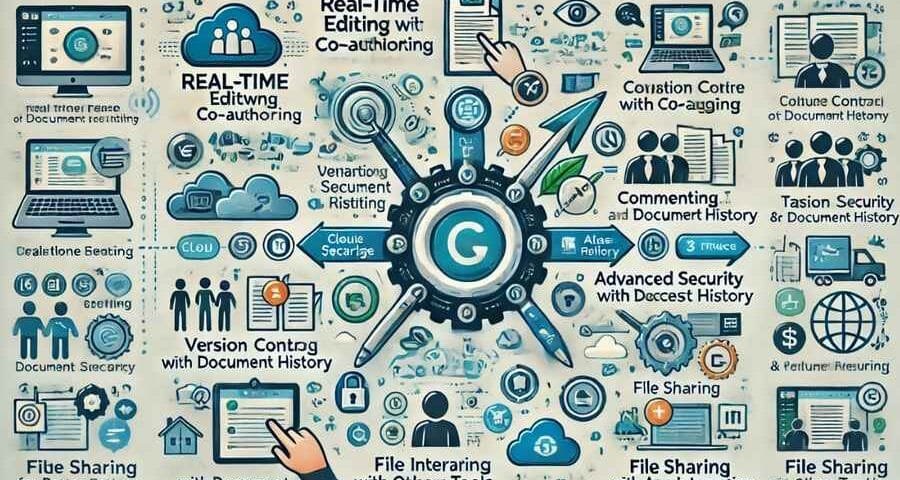
7 Powerful and Free Document Collaboration Tools for Small Businesses
November 2, 2024
5 Must-Try Cloud Document Collaboration Platforms for 2025
November 2, 2024Top Features of Document Collaboration Tools for Remote Teams: Enhance Efficiency & Productivity
As remote work becomes the norm, the need for efficient document collaboration tools has skyrocketed. For remote teams, document collaboration tools are more than just digital workspaces; they’re essential hubs where projects come to life through seamless real-time editing, commenting, and shared task management. This article breaks down the top features of document collaboration tools that remote teams need to stay connected, productive, and aligned in their workflows.
Table of Contents
Introduction: Why Document Collaboration Tools Matter for Remote Teams
Document collaboration tools have become indispensable for remote teams. With teams working across time zones and locations, the ability to edit, share, and manage documents in real time has redefined productivity. The best document collaboration tools offer features that go beyond basic sharing capabilities, allowing for smooth and secure collaboration, advanced integrations, and customizable workflows. In this guide, we’ll explore the top features every remote team needs to look for in a document collaboration tool.
1. Real-Time Editing and Co-Authoring
One of the defining features of any document collaboration tool is real-time editing, which allows team members to make changes simultaneously. This feature minimizes the risk of version conflicts, as changes appear immediately on every user’s screen. Co-authoring capabilities enable multiple users to contribute content, view each other’s edits, and provide feedback directly within the document.
Benefits of Real-Time Editing:
- Enhances productivity by reducing the need for back-and-forth emails
- Promotes teamwork, as everyone sees updates and can contribute in real time
- Reduces versioning issues, ensuring the latest document version is always accessible
Top Tools with This Feature: Google Docs, Microsoft 365, Notion
2. Commenting, Tagging, and Notifications
Effective communication is the backbone of any collaborative tool. Commenting allows users to leave feedback, tag specific team members, and respond to each other within the document. This is particularly useful in review stages, where teams can quickly discuss edits and suggest improvements.
Why Commenting Matters:
- Encourages direct and context-specific feedback, reducing misunderstandings
- Helps maintain organized conversations on specific topics
- Tagging allows team members to receive notifications, ensuring they see relevant feedback promptly
Top Tools with This Feature: Slack, Quip, Asana
3. Version Control and Document History
For teams working on complex projects, tracking changes and accessing previous versions is essential. Version control and document history features allow users to review all modifications, restore older versions, and track who made specific edits.
Advantages of Version Control:
- Reduces the risk of losing valuable data, as previous versions are accessible
- Makes it easy to reverse unwanted changes, enhancing document security
- Offers transparency by showing an audit trail of changes
Top Tools with This Feature: Microsoft 365, Dropbox Paper, Confluence
4. Cloud Storage and Accessibility
Cloud storage has revolutionized remote work, providing easy access to documents from anywhere with an internet connection. Top document collaboration tools integrate with cloud storage providers or come with built-in storage, making it easier for remote teams to save, organize, and access documents securely.
Key Benefits:
- Ensures documents are accessible from any device or location
- Minimizes data loss by automatically backing up files
- Simplifies file sharing, as files can be accessed with a link
Top Tools with This Feature: Google Workspace, Dropbox Paper, ClickUp
5. Advanced Security and Access Permissions
Security is paramount when it comes to document collaboration, especially for remote teams that rely on digital platforms to handle sensitive information. Access permissions enable managers to control who can view, edit, or share documents, helping protect data privacy and security.
Why This Matters:
- Ensures sensitive data is accessible only to authorized team members
- Allows granular control over permissions, enhancing document security
- Compliance with data regulations is easier to manage with secure tools
Top Tools with This Feature: Microsoft 365, Box, Confluence
6. Task Management and Workflow Integration
Many document collaboration tools now offer task management features, allowing teams to assign tasks, set deadlines, and track progress within documents. Some even integrate with project management tools, providing a streamlined workflow that keeps everyone on track.
How Task Management Boosts Productivity:
- Keeps all project-related tasks in one place, reducing tool-switching
- Helps track task status, making it easy to monitor project progress
- Encourages accountability by assigning specific tasks to team members
Top Tools with This Feature: Notion, ClickUp, Asana
7. Templates for Faster Document Creation
Templates are powerful time-savers, especially for recurring documents such as reports, project plans, or marketing content. Many document collaboration tools offer pre-made templates or allow users to create custom ones, helping teams start with a structured layout.
Benefits of Templates:
- Saves time by providing ready-made layouts for common document types
- Maintains consistency across documents, which is useful for branding
- Reduces the setup time, allowing teams to focus on content creation
Top Tools with This Feature: Notion, Airtable, Microsoft 365
8. File Sharing and Integration with Other Tools
Seamless file sharing and integration with other apps can significantly improve productivity by reducing the need to switch between tools. Integrations with popular platforms such as Slack, Salesforce, and Trello make it easier to streamline workflows, share updates, and collaborate more effectively.
How Integrations Improve Collaboration:
- Allows teams to share files within preferred tools like Slack or email
- Reduces the need for repetitive tasks by automating workflows
- Ensures a unified workspace by connecting various tools into one ecosystem
Top Tools with This Feature: Slack, Microsoft 365, Asana
9. Offline Editing Capabilities
Not all team members may have consistent internet access. Offline editing is a valuable feature that allows users to make changes while offline, with the updates synced automatically once a connection is restored.
Why Offline Editing Is Important:
- Enables remote teams to work from any location without disruption
- Reduces downtime caused by internet connectivity issues
- Ensures documents are always accessible, regardless of network status
Top Tools with This Feature: Google Workspace, Microsoft 365, Dropbox Paper
Top Features of Document Collaboration Tools for Remote Teams: Enhance Efficiency & Productivity Recap
Top Features of Document Collaboration Tools for Remote Teams
| Feature | Description | Benefits | Top Tools |
|---|---|---|---|
| Real-Time Editing | Allows multiple users to edit documents simultaneously. |
– Enhances productivity – Reduces versioning conflicts – Promotes teamwork | Google Workspace, Microsoft 365, Notion |
| Commenting & Tagging | Facilitates feedback and direct communication within documents. |
– Reduces misunderstandings – Ensures prompt attention – Keeps feedback organized | Slack, Quip, Asana |
| Version Control | Keeps track of all changes, allowing users to revert to previous versions. |
– Protects data integrity – Enhances transparency – Facilitates long-term projects | Microsoft 365, Dropbox Paper, Confluence |
| Cloud Storage | Enables document access and sharing from anywhere with an internet connection. |
– Provides secure access – Simplifies sharing – Offers automatic backups | Google Workspace, Dropbox, ClickUp |
| Task Management | Integrates task tracking and workflow management into documents. |
– Reduces tool-switching – Tracks progress – Increases accountability | Notion, ClickUp, Asana |
| Offline Editing | Allows users to work on documents without an internet connection. |
– Prevents downtime – Enables flexibility – Syncs updates automatically | Google Workspace, Microsoft 365, Dropbox Paper |
Frequently Asked Questions
What are the essential features of document collaboration tools? Essential features include real-time editing, version control, task management, commenting, secure access permissions, and cloud storage. These features enable seamless collaboration, effective communication, and efficient project tracking.
How do document collaboration tools improve productivity for remote teams? These tools improve productivity by enabling real-time collaboration, centralizing task and project management, and reducing the need for multiple platforms. Features like commenting, task assignments, and integration with other tools make workflows smoother, allowing remote teams to stay aligned.
Are document collaboration tools secure? Yes, most document collaboration tools prioritize security with features like access permissions, data encryption, and secure cloud storage. Advanced tools often offer compliance certifications and multi-factor authentication to ensure data protection.
Conclusion: Choosing the Right Document Collaboration Tool for Your Remote Team
Selecting the right document collaboration tool depends on the unique needs of your remote team. Tools like Google Workspace and Microsoft 365 offer comprehensive features suitable for large teams, while options like Notion and ClickUp provide flexibility and all-in-one functionality for startups and creative teams.
Each feature, from real-time editing to integration capabilities, contributes to a more cohesive and productive work environment. By understanding the essential features of these tools, you can equip your team with the technology needed to collaborate effectively in the digital age. Whether your team needs robust security, task management, or advanced integration options, there’s a document collaboration tool to match every requirement.







